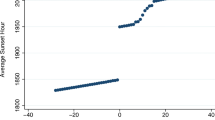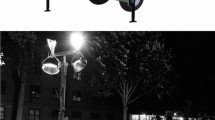Abstract
We use National Incident-Based Reporting System (NIBRS) data and an AutoRegressive Integrative Moving Average (ARIMA) study design to investigate the effect of moon illumination on reported crime occurring outdoors between the hours of 10 pm to 2 am in 13 U.S. states and the District of Columbia. Prior research analyzed a confounded dependent variable that amalgamated indoor and outdoor crimes. This situation is problematic in that there is little reason to speculate a relationship between moon illumination and indoor crime because artificial illumination is used within dwellings. Findings show that while moon illumination has little influence on total crime and indoor crime, the intensity of moonlight does have a substantive positive effect on outdoor criminal activity. As moon illumination intensifies, outdoor crime increases markedly. Plausible explanations for this relationship are discussed.
Similar content being viewed by others
References
Andresen, M. A. (2014). Environmental criminology: Evolution, theory, and practice. New York: Routledge.
Bennett, C. (1977). Spaces for people: Human factors in design. NJ: Prentice Hall.
Box, G. E. P., Jenkins, G. M., Reinsel, G. C. & Ljung, G. M. (2016). Time series analysis: Forecasting and control, 5th Edition. New Jersey: John Wiley & Sons.
Cozens, P. M., Saville, G., & Hillier, D. (2005). Crime prevention through environmental design (CPTED): A review and modern bibliography. Property Management, 23, 328–356.
Department of Justice (2006). Crime in the United States, (2004). www.fbi.gov/urc/cius_04/offenses_reported/property_crime/burglary.html.
Dickey, D. A., Bell, W. R., & Miller, R. B. (1986). Unit roots in time series models: Tests and implications. The American Statistician, 40, 12–26.
Hough, M. (1987). Offenders’ choice of target: Findings from victim surveys. Journal of Quantitative Criminology, 3, 355–369.
IBM Corp. (2011). IBM SPSS statistics for windows, version 20.0.. Armonk: IBM Corp.
Keane, C. (1998). Evaluating the influence of fear of crime as an environmental mobility restrictor on women’s routine activities. Environment and Behavior, 30, 60–74.
Lieber, A. L. (1978). The lunar effect: Biological tides and human emotions. NY: Doubleday.
Lilienfeld, S. O., & Arkowitz, H. (2008). Lunacy and the full moon: Does a full moon really trigger strange behavior? Scientific American Mind, 20, 64–65.
Ljung, G. M., & Box, G. E. P. (1978). On a measure of lack of fit in time series models. Biometrika, 65, 297–303.
Mesch, G. S. (2000). Perceptions of risk, lifestyle activities, and fear of crime. Deviant Behavior, 21, 47–62.
Miethe, T. D., Stafford, M. C., & Long, J. S. (1987). Social differentiation in criminal victimization: A test of routine activities/lifestyle theories. American Sociological Review, 52, 184–194.
National Archive of Criminal Justice Data. (2014). National Incident-Based Reporting System, 2014: Extract Files. ICPSR36421-v1.
Núñez, S., Pérez Méndez, L., & Aguirre-Jaime, A. (2002). Moon cycles and violent behaviours: Myth or fact? European Journal of Emergency Medicine, 9, 127–130.
Painter, K. (1996). The influence of street lighting improvements on crime, fear and pedestrian street use, after dark. Landscape and Urban Planning, 35, 193–201.
Painter, K., & Farrington, D. P. (1999). Street lighting and crime: Diffusion of benefits in the Stoke-on-Trent project evaluation. In K. Painter & N. Tilley (Eds.), Surveillance of public space: CCTV, street lighting and crime prevention (Vol. 10). Monsey: Criminal Justice Press.
Quinet, K. D., & Nunn, S. (1998). Illuminating crime: The impact of street lighting on calls for police service. Evaluation Review, 22, 751–779.
Rotton, J., & Kelly, I. W. (1985). Much ado about the full moon: A meta-analysis of lunar-lunacy research. Psychological Bulletin, 97, 286–306.
Schafer, J. A., Varano, S. P., Jarvis, J. P., & Cancino, J. M. (2010). Bad moon on the rise? Lunar cycles and incidents of crime. Journal of Criminal Justice, 38, 359–367.
Stellwagen, E. A., & Goodrich, R. L. (2011). Forecast pro EX user’s guide. Software version 6. Belmont: Business Forecast Systems, Inc.
Templer, D. I., Veleber, D. M., & Brooner, R. K. (1982). Geophysical variables and behavior: VI. Lunar phase and accident injuries—a difference between night and day. Perceptual and Motor Skills, 55, 280–82.
U. S. Naval Observatory. (2014). Fraction of the moon illuminated at midnight eastern standard time. Washington, DC: Astron. Applications Department.
Van Dijk, J. J., & Steinmetz, C. H. D. (1983). Victimization surveys: Beyond measuring the volume of crime. Victimology, 8, 291–309.
Welsh, B. C., & Farrington, D. P. (2004). Surveillance for crime prevention in public space: Results and policy choices in Britain and America. Criminology and Public Policy, 3, 497–526.
Author information
Authors and Affiliations
Corresponding author
Additional information
This research received no specific grant from any funding agency in the public, commercial, or not-for-profit sectors.
Rights and permissions
About this article
Cite this article
Stolzenberg, L., D’Alessio, S.J. & Flexon, J.L. A Hunter’s Moon: the Effect of Moon Illumination on Outdoor Crime. Am J Crim Just 42, 188–197 (2017). https://doi.org/10.1007/s12103-016-9351-9
Received:
Accepted:
Published:
Issue Date:
DOI: https://doi.org/10.1007/s12103-016-9351-9




